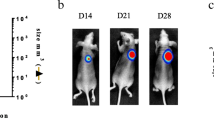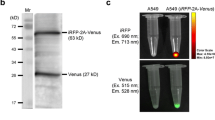Abstract
The Lewis lung carcinoma has been widely used for many important studies. However, the subcutaneous transplant or orthotopic cell-suspension injection models have not allowed the expression of its full metastatic potential. A powerful new highly metastatic model of the widely-used Lewis lung carcinoma is reported here using surgical orthotopic implantation (SOI) of tumor fragments and enhanced green fluorescent protein (GFP) transduction of the tumor cells. To achieve this goal, we first developed in vitro a stable high-expression GFP transductant of the Lewis lung carcinoma with the pLEIN retroviral expression vector containing the enhanced Aequorea victoria GFP gene. Stable high-level expression of GFP was found maintained in vivo in subcutaneously-growing Lewis lung tumors. The in vivo GFP-expressing tumors were harvested and implanted as tissue fragments by SOI in the right lung of additional nude mice. This model resulted in rapid orthotopic growth and extensive metastasis visualized by GFP-expression. 100% of the animals had metastases on the ipsilateral diaphragmatic surface, contralateral diaphragmatic surface, contralateral lung parenchima, and in mediastinal lymph nodes. Heart metastases were visualized in 40%, and brain metastases were visualized in 30% of the SOI animals. Mice developed signs of respiratory distress between 10–15 days post-tumor implantation and were sacrificed. The use of GFP-transduced Lewis lung carcinoma transplanted by SOI reveals for the first time the high malignancy of this tumor and provides an important useful model for metastasis, angiogenesis and therapeutic studies.
Similar content being viewed by others
References
Sugiura K, Stock CC. Studies in a tumor spectrum. III. The effect of phosphoramides on the growth of a variety of mouse and rat tumors. Cancer Res 1955; 15: 38–51.
O’Reilly M, Holmgren L, Shing Y et al. Angiostatin: A novel angiogenesis inhibitor that mediates the suppression of metastases by a Lewis lung carcinoma. Cell 1994; 79: 315–25.
Fichtner I, Tanneberger S. Preoperative (neoadjuvant) chemotherapy in the murine Lewis lung carcinoma and possible implications for clinical use. Anticancer Research 1987; 7: 227–33.
Himmele JC, Rabenhorst B, Werner D. Inhibition of Lewis lung tumor growth and metastases by Ehrlich ascites tumor growth in the same host. J Cancer Res Clin. Oncol. 1986; 111: 160–165.
Gorelik E, Segal S, Feldman M. Control of lung metastases progression in mice: role of growth kinetic of 3LL Lewis lung carcinoma and host immunity reactivity. J Natl Cancer Inst 1980; 65: 1257–64.
Rashidi B, An Z, Sun F-X et al. Minimal liver resection strongly stimulates the growth of human colon cancer in the liver of nude mice. Clin Exp Metastasis 1999; 17: 497–500.
An Z, Jiang P, Wang X, Moossa AR, Hoffman RM. Development of a high metastatic orthotopic model of human renal cell carcinoma in nude mice: benefits of fragment implantation compared to cell-suspension injection. Clin Exp Metastasis 1999; 17: 265–270.
Hoffman RM. Orthotopic metastatic mouse models for anticancer drug discovery evaluation: a bridge to the clinic. Invest New Drugs 1999; 17: 343–59.
Hoffman RM. Orthotopic is orthodox: Why are orthotopic transplant metastatic models different from all other models? J Cell Biochem 1994; 56: 1–3.
Wang X, Fu X, Hoffman RM. A new patient-like metastatic model of human lung cancer constructed orthotopically with intact tissue via thoracotomy in immunodeficient mice. Int J Cancer 1992; 51: 992–5.
Wang X, Fu X, Hoffman RM. A patient-like metastasizing model of human lung adenocarcinoma constructed via thoracotomy in nude mice. Anticancer Res 1992; 12: 1399–1402.
Li L, Shin DM, Fidler IJ. Intrabronchial implantation of the Lewis lung tumor cell does not favor tumorigenocity and metastasis. Invasion Metastases 1990; 10: 129–41.
Doki Y, Murakami K, Yamamura T. et al. Mediastinal lymph node metastasis model by orthotopic intrapulmonary implantation of Lewis lung carcinoma cells in mice. Br J Cancer 1999; 79: 1121–6.
Chishima T, Miyagi Y, Wang X et al. Cancer invasion and micrometastasis visualized in live tissue by green fluorescent protein expression. Cancer Res 1997; 57: 2042–7.
Chishima T, Miyagi Y, Wang X et al. Metastatic patterns of lung cancer visualized live and in process by green fluorescent protein expression. Clin Exp Metastasis 1997; 15: 547–52.
Yang M, Hasegawa S, Jiang P et al. Widespread skeletal metastatic potential of human lung cancer revealed by green fluorescent protein expression. Cancer Res 1998; 58: 4217–21.
Author information
Authors and Affiliations
Rights and permissions
About this article
Cite this article
Rashidi, B., Yang, M., Jiang, P. et al. A highly metastatic Lewis lung carcinoma orthotopic green fluorescent protein model. Clin Exp Metastasis 18, 57–60 (2000). https://doi.org/10.1023/A:1026596131504
Issue Date:
DOI: https://doi.org/10.1023/A:1026596131504




